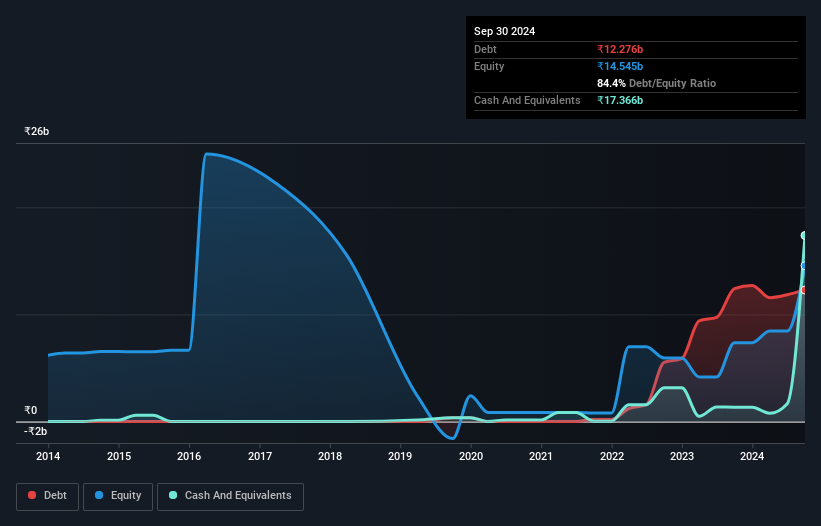- India
- /
- General Merchandise and Department Stores
- /
- NSEI:RTNINDIA
These 4 Measures Indicate That RattanIndia Enterprises (NSE:RTNINDIA) Is Using Debt Reasonably Well

The external fund manager backed by Berkshire Hathaway's Charlie Munger, Li Lu, makes no bones about it when he says 'The biggest investment risk is not the volatility of prices, but whether you will suffer a permanent loss of capital.' So it seems the smart money knows that debt - which is usually involved in bankruptcies - is a very important factor, when you assess how risky a company is. We can see that RattanIndia Enterprises Limited (NSE:RTNINDIA) does use debt in its business. But should shareholders be worried about its use of debt?
When Is Debt A Problem?
Debt is a tool to help businesses grow, but if a business is incapable of paying off its lenders, then it exists at their mercy. Ultimately, if the company can't fulfill its legal obligations to repay debt, shareholders could walk away with nothing. However, a more frequent (but still costly) occurrence is where a company must issue shares at bargain-basement prices, permanently diluting shareholders, just to shore up its balance sheet. Of course, debt can be an important tool in businesses, particularly capital heavy businesses. When we think about a company's use of debt, we first look at cash and debt together.
Check out our latest analysis for RattanIndia Enterprises
What Is RattanIndia Enterprises's Debt?
The chart below, which you can click on for greater detail, shows that RattanIndia Enterprises had ₹12.3b in debt in September 2024; about the same as the year before. However, its balance sheet shows it holds ₹17.4b in cash, so it actually has ₹5.09b net cash.

How Strong Is RattanIndia Enterprises' Balance Sheet?
The latest balance sheet data shows that RattanIndia Enterprises had liabilities of ₹21.7b due within a year, and liabilities of ₹1.77b falling due after that. Offsetting this, it had ₹17.4b in cash and ₹1.66b in receivables that were due within 12 months. So its liabilities outweigh the sum of its cash and (near-term) receivables by ₹4.43b.
Since publicly traded RattanIndia Enterprises shares are worth a total of ₹86.4b, it seems unlikely that this level of liabilities would be a major threat. Having said that, it's clear that we should continue to monitor its balance sheet, lest it change for the worse. While it does have liabilities worth noting, RattanIndia Enterprises also has more cash than debt, so we're pretty confident it can manage its debt safely.
Notably, RattanIndia Enterprises's EBIT launched higher than Elon Musk, gaining a whopping 198% on last year. There's no doubt that we learn most about debt from the balance sheet. But you can't view debt in total isolation; since RattanIndia Enterprises will need earnings to service that debt. So when considering debt, it's definitely worth looking at the earnings trend. Click here for an interactive snapshot.
Finally, while the tax-man may adore accounting profits, lenders only accept cold hard cash. RattanIndia Enterprises may have net cash on the balance sheet, but it is still interesting to look at how well the business converts its earnings before interest and tax (EBIT) to free cash flow, because that will influence both its need for, and its capacity to manage debt. During the last three years, RattanIndia Enterprises burned a lot of cash. While that may be a result of expenditure for growth, it does make the debt far more risky.
Summing Up
We could understand if investors are concerned about RattanIndia Enterprises's liabilities, but we can be reassured by the fact it has has net cash of ₹5.09b. And we liked the look of last year's 198% year-on-year EBIT growth. So we don't have any problem with RattanIndia Enterprises's use of debt. When analysing debt levels, the balance sheet is the obvious place to start. However, not all investment risk resides within the balance sheet - far from it. We've identified 1 warning sign with RattanIndia Enterprises , and understanding them should be part of your investment process.
When all is said and done, sometimes its easier to focus on companies that don't even need debt. Readers can access a list of growth stocks with zero net debt 100% free, right now.
New: AI Stock Screener & Alerts
Our new AI Stock Screener scans the market every day to uncover opportunities.
• Dividend Powerhouses (3%+ Yield)
• Undervalued Small Caps with Insider Buying
• High growth Tech and AI Companies
Or build your own from over 50 metrics.
Have feedback on this article? Concerned about the content? Get in touch with us directly. Alternatively, email editorial-team (at) simplywallst.com.
This article by Simply Wall St is general in nature. We provide commentary based on historical data and analyst forecasts only using an unbiased methodology and our articles are not intended to be financial advice. It does not constitute a recommendation to buy or sell any stock, and does not take account of your objectives, or your financial situation. We aim to bring you long-term focused analysis driven by fundamental data. Note that our analysis may not factor in the latest price-sensitive company announcements or qualitative material. Simply Wall St has no position in any stocks mentioned.
About NSEI:RTNINDIA
RattanIndia Enterprises
Engages in the manpower, human resource supply and consultancy, payroll management, technology, and other related services in India.
Slightly overvalued with questionable track record.
Market Insights
Community Narratives




